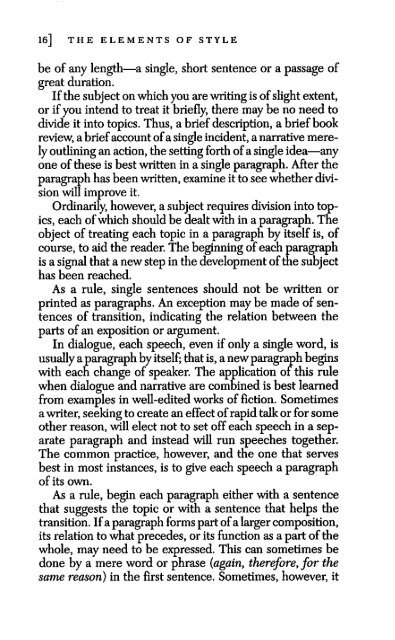You also want an ePaper? Increase the reach of your titles
YUMPU automatically turns print PDFs into web optimized ePapers that Google loves.
16] THE ELEMENTS OF STYLE<br />
be of any length—a single, short sentence or a passage of<br />
great duration.<br />
If the subject on which you are writing is of slight extent,<br />
or if you intend to treat it briefly, there may be no need to<br />
divide it into topics. Thus, a brief description, a brief book<br />
review, a brief account of a single incident, a narrative mere<br />
ly oudining an action, the setting forth of a single idea—any<br />
one of these is best written in a single paragraph. After the<br />
paragraph has been written, examine it to see whether divi<br />
sion will improve it.<br />
Ordinarily, however, a subject requires division into top<br />
ics, each of which should be dealt with in a paragraph. <strong>The</strong><br />
object of treating each topic in a paragraph by itself is, of<br />
course, to aid the reader. <strong>The</strong> beginning of each paragraph<br />
is a signal that a new step in the development of the subject<br />
has been reached.<br />
As a rule, single sentences should not be written or<br />
printed as paragraphs. An exception may be made of sen<br />
tences of transition, indicating the relation between the<br />
parts of an exposition or argument.<br />
In dialogue, each speech, even if only a single word, is<br />
usually a paragraph by itself; that is, a new paragraph begins<br />
widi each change of speaker. <strong>The</strong> application of this rule<br />
when dialogue and narrative are combined is best learned<br />
from examples in well-edited works of fiction. Sometimes<br />
a writer, seeking to create an effect of rapid talk or for some<br />
other reason, will elect not to set off each speech in a sep<br />
arate paragraph and instead will run speeches together.<br />
<strong>The</strong> common practice, however, and the one that serves<br />
best in most instances, is to give each speech a paragraph<br />
of its own.<br />
As a rule, begin each paragraph either with a sentence<br />
that suggests the topic or with a sentence that helps the<br />
transition. If a paragraph forms part of a larger composition,<br />
its relation to what precedes, or its function as a part of the<br />
whole, may need to be expressed. This can sometimes be<br />
done by a mere word or phrase (again, therefore, for the<br />
same reason) in the first sentence. Sometimes, however, it


